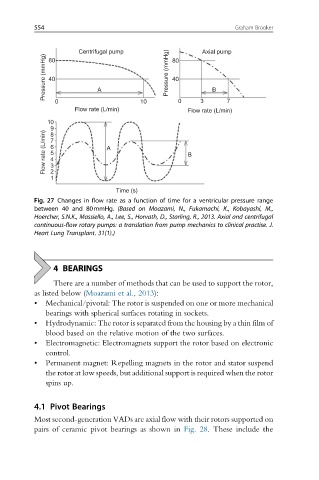Page 561 - Handbook of Biomechatronics
P. 561
554 Graham Brooker
Centrifugal pump 80 Axial pump
Pressure (mmHg) 40 A Pressure (mmHg) 40 B
80
0 10 0 3 7
Flow rate (L/min) Flow rate (L/min)
10
9
Flow rate (L/min) 7 A B
8
6
5
4
3
2
1
Time (s)
Fig. 27 Changes in flow rate as a function of time for a ventricular pressure range
between 40 and 80mmHg. (Based on Moazami, N., Fukamachi, K., Kobayashi, M.,
Hoercher, S.N.K., Massiello, A., Lee, S., Horvath, D., Starling, R., 2013. Axial and centrifugal
continuous-flow rotary pumps: a translation from pump mechanics to clinical practise. J.
Heart Lung Transplant. 31(1).)
4 BEARINGS
There are a number of methods that can be used to support the rotor,
as listed below (Moazami et al., 2013):
• Mechanical/pivotal: The rotor is suspended on one or more mechanical
bearings with spherical surfaces rotating in sockets.
• Hydrodynamic: The rotor is separated from the housing by a thin film of
blood based on the relative motion of the two surfaces.
• Electromagnetic: Electromagnets support the rotor based on electronic
control.
• Permanent magnet: Repelling magnets in the rotor and stator suspend
the rotor at low speeds, but additional support is required when the rotor
spins up.
4.1 Pivot Bearings
Most second-generation VADs are axial flow with their rotors supported on
pairs of ceramic pivot bearings as shown in Fig. 28. These include the

